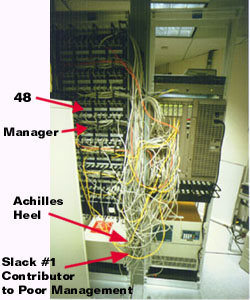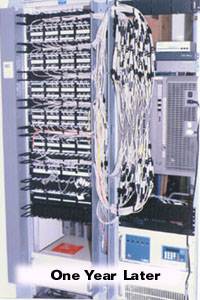 |
|
|
Why
two 48-port patch panels, instead of one 96-port panel,
will not remedy patch-cord management problems. |
| It is industry "group think"
that a 96-port patch panel would cause management problems due to the density
of many cords plugged into a small amount of space (i.e. 7" vertical space
or 4-rack mount space {RMS} for a high density modular patch panel). "Group
Think" resolution to this problem would be to raise equipment cost and increase
space for management by using two 48-port panels and installing an additional
horizontal manager between the two patch panels. This approach has been
stated in many industry articles. |
| One might agree with this resolution.
But, why do they make 96-port patch panels? To cause you problems? To make
you increase the number of racks to compensate for this monster of a patch
panel? |
|
Think About This. Even if you went
through the additional expense and installed two 48-port patch panels
and one horizontal patch-cord manager instead of one 96-port panel,
this whole philosophy goes down the tubes when it comes to chassis-
type contractors (hubs). This is where port density can range far
beyond 96 ports with no horizontal management to split this up (diagram
1).
Study Proves Group Thinking Is Wrong.
In the industry's most comprehensive study of patch-cord management,
from which excerpts were published in the February 1997 issue of
the magazine Cabling Installation & Maintenance (candidate for CI&M
--Hall of Fame article of the year). The inspection team examined
473 patch panels in 87 telecommunications rooms with a variety of
patch panels ranging from 24- to 96-ports. In all, 16,242 patch
cords were inspected, along with 723 horizontal patch-cord managers
and 1066 vertical managers (see diagram 2).
|
 |
| Diagram
1 |
|
|
|
|
|
Industry
Study
|
 |
|
Diagram 2
|
|
| The inspectors took detailed
information from each of the patch-cord management systems--patch-cord slack,
bend radius, port density, etc.--to ascertain common characteristics in
patch cords, cross-connect fields, and field installation practices. As
mentioned in the first issue of this newsletter, when proper and adequate
horizontal and vertical managers are utilized in the management system,
patch-cord routing will cause patch-cord slack. This slack results in poor
patch-cord management when not minimized or eliminated (click
here to view first issue of this newsletter). Pinpointing the area where
the slack will occur (Achilles heel - diagram 3) and compensating for it
in the design stage to correct patch-cord slack. When patch-cord adjusters
are utilized on each cord within the management system, slack is eliminated,
and management maintained throughout the life cycle (diagram 4).
|
 |
 |
| Diagram
3 -
48 port patch panels do not increase manageability
|
Diagram
4
- Installed patch-cord adjustgers on each cord has eliminated slack
and maintained system management. |
|
|
|
|
Proper Design of Horizontal Managers with 96-port
Patch Panels. Mount a horizontal manager above and below every
96-port patch panel or combination thereof (48 + 48 group into 96-ports
for optional use). This horizontal manager shall have a height of 2RMS
(3.5"/8.9cm) and a minimum depth on the rings or channel of at least 3"
(7.62cm). This arrangement causes fewer snags when modular plug tips are
removed from the horizontal manager. This sized manager allows more freedom
to add or remove patch cords. When there are more than 96-ports in either
single or multiple patch panels, a horizontal manager is used to separate
patch panels and shared between patch panels.
When using a 1 RMS (1.75"/4.45cm) horizontal manager because
of limited space requirements in a patch field, the depth on the rings
or channel should exceed 4". This is to provide additional space for patch
cords and reduce the plug-snagging effect that occur when patch cords
are located in tight, congested areas.
Conclusion
Contrary to group thinking, splitting one 96-port patch panel into two
48-port patch panels with adequate patch-cord management will not alleviate
the problems of slack, #1 contributor to poor management in the patch-cord
management system. It is how the patch-cord slack is eliminated during
or after a the patch is made within the management system that determines
the outcome of the patch-cord management field over it's life cycle.
|
|
|
PerfectPatch-Cord
Management News
Dennis
W. Mazaris, RCDD, Editor
Email
43766 Trade Center Place, Suite 130
Dulles, Virginia 20166
703-796-5408
www.perfectpatch.com
|
|
Previous
Issue
How a patch-cord is routed - the key to designing, a management system. |
| |
|
|
|


